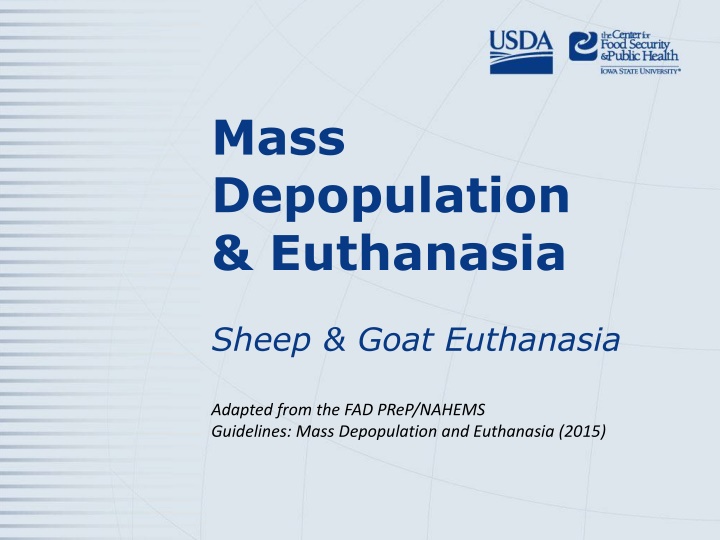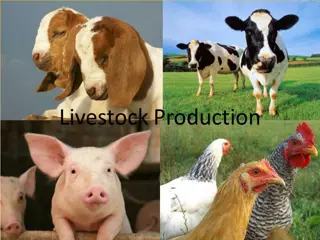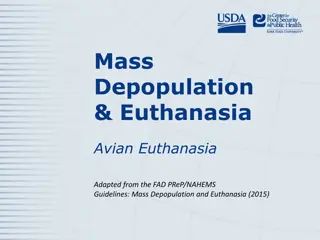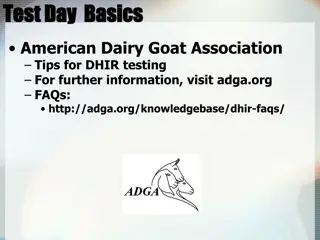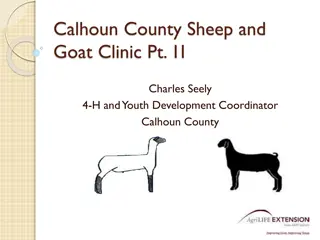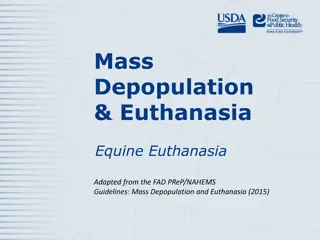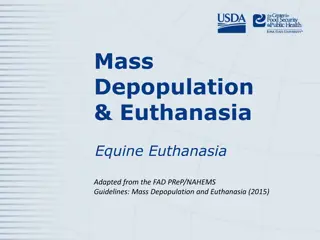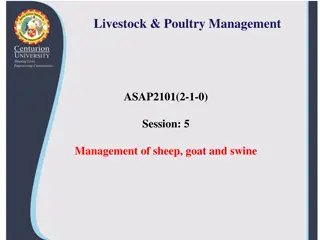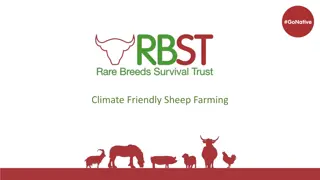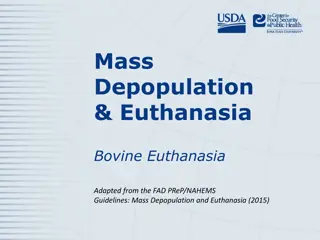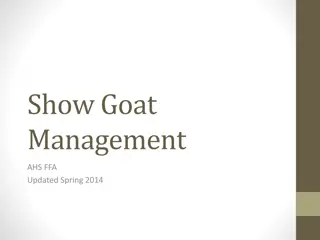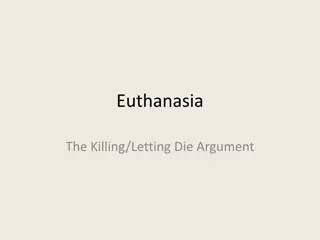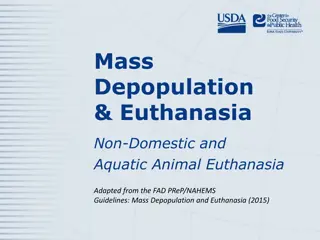Guidelines for Humane Sheep and Goat Euthanasia
Providing insights on mass depopulation and euthanasia techniques for sheep and goats during animal health emergencies. Focuses on humane handling, acceptable euthanasia methods, and considerations for minimizing stress and ensuring welfare. Emphasizes transitioning painlessly, safeguarding the food chain, and preventing disease spread.
Download Presentation

Please find below an Image/Link to download the presentation.
The content on the website is provided AS IS for your information and personal use only. It may not be sold, licensed, or shared on other websites without obtaining consent from the author.If you encounter any issues during the download, it is possible that the publisher has removed the file from their server.
You are allowed to download the files provided on this website for personal or commercial use, subject to the condition that they are used lawfully. All files are the property of their respective owners.
The content on the website is provided AS IS for your information and personal use only. It may not be sold, licensed, or shared on other websites without obtaining consent from the author.
E N D
Presentation Transcript
Mass Depopulation & Euthanasia Sheep & Goat Euthanasia Adapted from the FAD PReP/NAHEMS Guidelines: Mass Depopulation and Euthanasia (2015)
Euthanasia and Depopulation Euthanasia Transitioning painlessly and stress-free as possible Mass Depopulation Large numbers, quickly and efficiently Consideration to welfare as practicable Terms used interchangeably here FAD PReP/NAHEMS Guidelines: MDE-Sheep & Goat USDA APHIS and CFSPH
Euthanasia and Depopulation May be practiced during an animal health emergency Goals of Euthanasia Provide humane treatment Select acceptable method Minimize negative emotional impact Safeguard food chain Prevent or mitigate disease spread FAD PReP/NAHEMS Guidelines: MDE-Sheep & Goat USDA APHIS and CFSPH
Handling Goal: Humane Treatment Decrease animal stress, excitement Conveyors, tunnel electrocution system Do not force animals to travel quickly Avoid electric prods Human body position Flight zones Flags, plastic paddles Handle animals quietly FAD PReP/NAHEMS Guidelines: MDE-Sheep & Goat USDA APHIS and CFSPH
Euthanasia Methods Acceptable (noninhalant injectable) Barbiturates Barbiturate derivatives Conditionally Acceptable (physical) Penetrating captive bolt Gunshot Electrocution Carbon dioxide (sheep only) FAD PReP/NAHEMS Guidelines: MDE-Sheep & Goat USDA APHIS and CFSPH
Noninhalant Injectable Usually impractical Slow process Expensive Carcass disposal Record keeping Consider if animal is a companion/hand raised FAD PReP/NAHEMS Guidelines: MDE-Sheep & Goat USDA APHIS and CFSPH
Physical- Captive Bolt Use appropriate restraint to ensure personnel safety Bolt positioning Polled animal Horned animal Adjunct method available FAD PReP/NAHEMS Guidelines: MDE-Sheep & Goat USDA APHIS and CFSPH
Physical- Gunshot Conditionally acceptable Species-appropriate ammunition, appropriate caliber weapon Proper training, skills, experience Close range, same point of entry as captive bolt Muzzle 2-10 inches from entry point Mature goat brain is located much farther back than might be expected FAD PReP/NAHEMS Guidelines: MDE-Sheep & Goat USDA APHIS and CFSPH
Electrocution If used: Electric current through brain to stun Ear to ear, poll to muzzle Electric current through heart Sides of animal over heart FAD PReP/NAHEMS Guidelines: MDE-Sheep & Goat USDA APHIS and CFSPH
Carbon Dioxide Acceptable, but impractical euthanasia method Extensive infrastructure needed Truck or tight room could be used as chamber, with careful planning FAD PReP/NAHEMS Guidelines: MDE-Sheep & Goat USDA APHIS and CFSPH
Adjunct Methods Second shot IV potassium chloride or magnesium sulfate Pithing Exsanguination FAD PReP/NAHEMS Guidelines: MDE-Sheep & Goat USDA APHIS and CFSPH
Confirmation of Death Confirmation of death can be difficult Sustained lack of heartbeat and respiration Rigor mortis Evaluate by competent, experienced personnel FAD PReP/NAHEMS Guidelines: MDE-Sheep & Goat USDA APHIS and CFSPH
For More Information FAD PReP/NAHEMS Guidelines: Mass Depopulation and Euthanasia (MDE) (2015) http://www.aphis.usda.gov/fadprep MDE web-based training module http://naherc.sws.iastate.edu/ FAD PReP/NAHEMS Guidelines: MDE-Sheep & Goat USDA APHIS and CFSPH
Guidelines Content Authors (CFSPH): Rene Dewell DVM,MS Nichollette Rider, Veterinary Student Significant contributions to the content were provided by USDA APHIS VS: Lori P. Miller, PE Darrel K. Styles, DVM, PhD FAD PReP/NAHEMS Guidelines: MDE-Sheep & Goat USDA APHIS and CFSPH
Acknowledgments Development of this presentation was by the Center for Food Security and Public Health at Iowa State University through funding from the USDA APHIS Veterinary Services PPT Authors: Dawn Bailey, BS; Kerry Leedom Larson, DVM, MPH, PhD, DACVPM Reviewers: Glenda Dvorak, DVM, MPH, DACVPM: Cheryl L. Eia, JD, DVM, MPH, Patricia Futoma, BS, Veterinary Student, Rene Dewell DVM,MS
